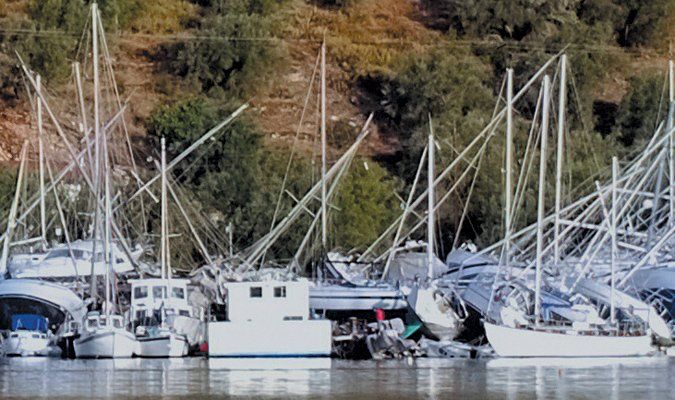In addition to the usual steps you take before a seasonal haul out at home (decommissioning the engine, storing sails, pickling systems, etc.), hauling out and leaving your boat in a new yard, especially a foreign port, involves some extra measures.
Points of Contact. Obtain detailed contact information for the yard or marina. Consider hiring a local marine trades person to check on the boat for you. Create a contact list for anyone doing work on the boat or equipment. Keep a copy and leave a copy aboard.
Clear decks, clean lockers. Marine supplies are often hard to find abroad. As you go through the boat make a list of supplies, emergency equipment (check expiration dates), and spare parts to purchase and bring back. Note any items that are regarded as hazardous for commercial flights and must be shipped separately.
Anchor Chain. If your rode is rusty, plan on regalvanizing it as soon as possible, as the chain will continue to rust and erode until regalvanized.
Rigging. Go up the mast and check all fittings, welds, spreaders, lights, halyards, cotter pins, turnbuckles, sheaves, swages and wires. Lubricate the upper furling swivel, track and masthead sheaves. Clean and grease all your winches and turnbuckles. Pull mast, and hire rigger (if needed) prior to leaving.
Sails. Remove all sails, including furling sails, rinse, dry, inspect and fold them. If repairs are needed, book sailmaker repairs done before leaving your boat. If you fix the sails yourself, check that you have all you need.
Interior. Often boats are left in the tropics, when mildew can flourish. Launder all interior fabrics, as any salty, damp or dirty fabric may mildew. Clean galley cupboards and throw out or give away all food that will go stale or perish while you are gone. Wipe all interior surfaces with an ammonia solution or Practical Sailors DIY mildew spray Formula A (see Mildew Treatments and Stain Removers, November 2013). Leave out roach and ant bait and consider setting off a bug bomb just before leaving if youre in a tropical location.
Life Raft. Note the repack date of your life raft and check about local repack facilities. You should arrange to be present once your raft is inflated to check the condition and supplies.
Medical. Check your medical kit noting expiration dates on all drugs and items that need replenishing. Check local prices and availability, it may be easier and more cost effective to purchase supplies when returning home.
Record Stowage. Before leaving, photograph everything for insurance purposes: cradle or marina slip, cover, interior and position of the boat in the yard. Notify insurance company and send it a copies of your photo record.
Before Hauling Out. Show the lift operator a photo or diagram of your boats underbody, marking ideal strap placement locations with masking tape. Request the most secure location in the storage area for your boat. The ideal location will be out of the regular traffic pattern of the Travelift and will be protected from strong winds from any direction. Several tropical boatyards have recently had boats blown over in strong winds.
Offshore sailing experts John and Amanda Neal are frequent PS contributors (www.mahina.com).

































